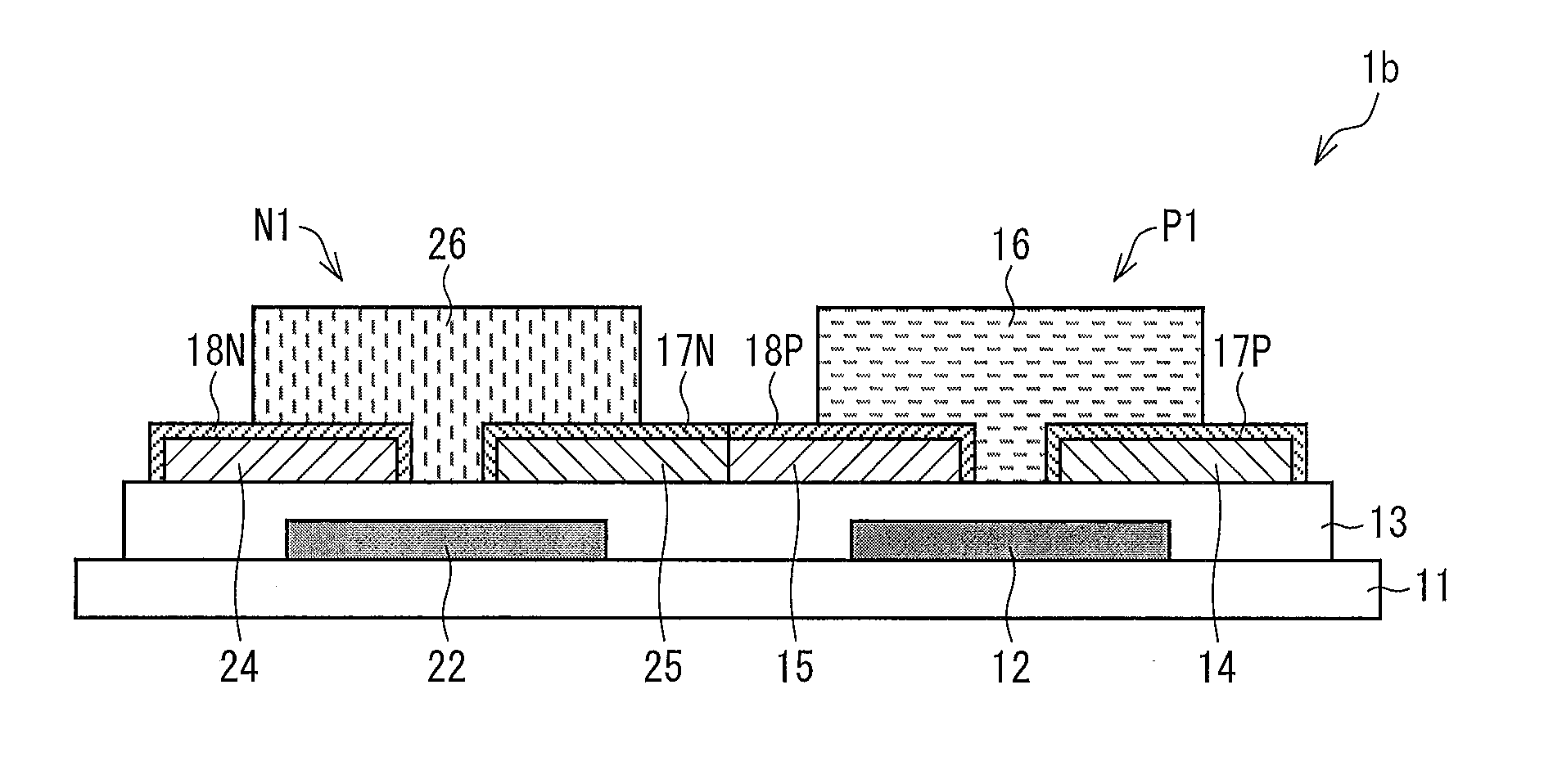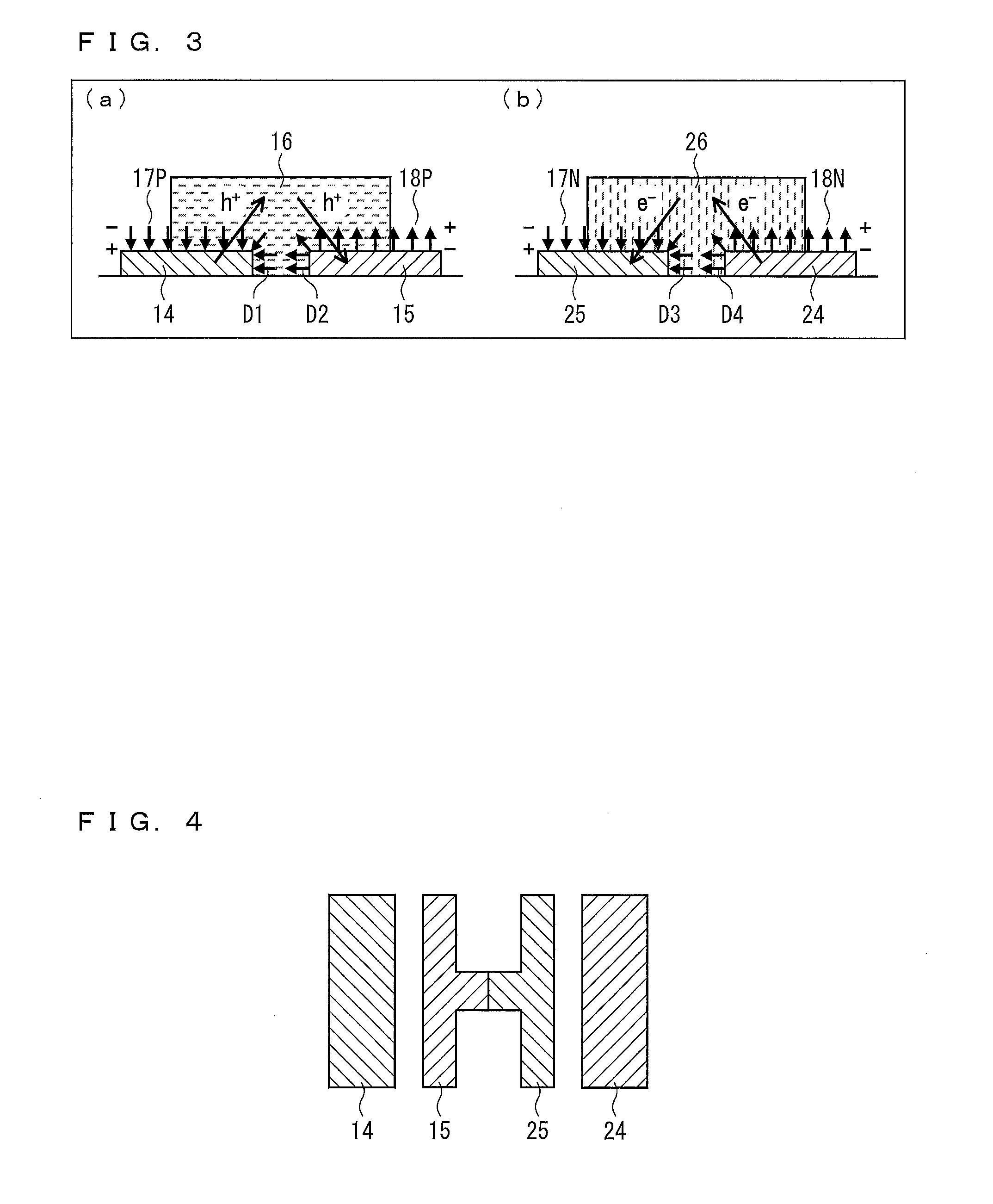Semiconductor device and method for manufacturing semiconductor device
- Summary
- Abstract
- Description
- Claims
- Application Information
AI Technical Summary
Benefits of technology
Problems solved by technology
Method used
Image
Examples
embodiment 1
[0051]The following description will discuss, with reference to FIGS. 1 through 7, an embodiment of a semiconductor device in accordance with the present invention.
[0052](Configuration of Semiconductor Device and Organic Transistors)
[0053]FIG. 1 is a cross-sectional view illustrating a schematic configuration of a semiconductor device of the present embodiment. As illustrated in FIG. 1, a semiconductor device 1a includes a p-type organic transistor (hereinafter simply referred to as a p-type transistor) P1 and an n-type organic transistor (hereinafter simply referred to as an n-type transistor) N1, which are provided on a same substrate 11. Each of the p-type transistor P1 and the n-type transistor N1 is a field-effect transistor whose semiconductor layer is made from an organic material.
[0054]The p-type transistor P1 is a bottom gate transistor, and includes (i) the substrate 11, (ii) a gate electrode (first gate electrode) 12 which is for the p-type transistor and is provided on t...
embodiment 2
[0144]The following description will discuss, with reference to FIGS. 8 through 11, another embodiment of the semiconductor device in accordance with the present invention. For convenience, the same reference signs will be given to members having the respective same functions as those used in Embodiment 1, and descriptions on such members will be omitted.
[0145]FIG. 8 is a cross-sectional view illustrating a schematic configuration of a semiconductor device of the present embodiment. As illustrated in FIG. 8, a semiconductor device 1b includes an n-type transistor N1 and a p-type transistor P1 which are provided on a same substrate 11. The semiconductor device 1b is different from the semiconductor device 1a of embodiment 1 in that the positions where the n-type transistor N1 and the p-type transistor P1 are reversed.
[0146]The semiconductor device 1b has a configuration in which a drain electrode 15 of the p-type transistor P1 and a drain electrode 25 of the n-type transistor N1 are ...
embodiment 3
[0167]The following description will discuss, with reference to FIGS. 15 and 16, still another embodiment of the semiconductor device in accordance with the present invention. For convenience, the same reference signs will be given to members having the respective same functions as those used in Embodiments 1 and 2, and descriptions on such members will be omitted.
[0168](a) of FIG. 15 is a cross-sectional view illustrating a schematic configuration of a semiconductor device of the present embodiment. Like the semiconductor device 1a illustrated in FIG. 1, a semiconductor device 1c includes an n-type transistor N1 and a p-type transistor P1 which are provided on a same substrate 11. The semiconductor device 1c has a configuration different from that of the semiconductor device 1a in that self-assembled monolayers constituting respective first layers 17P and 17N and self-assembled monolayers constituting respective second layers 18P and 18N in the semiconductor device 1c are each cons...
PUM
 Login to View More
Login to View More Abstract
Description
Claims
Application Information
 Login to View More
Login to View More - R&D
- Intellectual Property
- Life Sciences
- Materials
- Tech Scout
- Unparalleled Data Quality
- Higher Quality Content
- 60% Fewer Hallucinations
Browse by: Latest US Patents, China's latest patents, Technical Efficacy Thesaurus, Application Domain, Technology Topic, Popular Technical Reports.
© 2025 PatSnap. All rights reserved.Legal|Privacy policy|Modern Slavery Act Transparency Statement|Sitemap|About US| Contact US: help@patsnap.com



